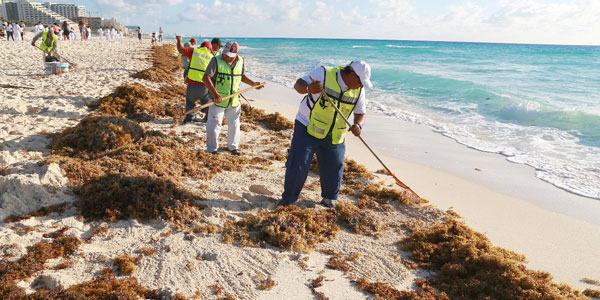
By Jorge Ramos
MAYAN RIVIERA, MEXICO — Our feverish oceans are spitting out hurricanes. They are spewing invasive seaweed onto our beaches. Beneath the water, the coral is turning pale. Something is wrong, very wrong. And the seas are trying to tell us something.
Two or three times a year my family and I travel to a wonderful area here between Cancún and Tulúm, in the state of Quintana Roo. It’s my favorite beach; the sand is smooth and white, the waters a deep turquoise. Every time I’m here, I get the sensation that I’m in the best place in the world. But during the last few visits I’ve seen a drastic change: The beach is often covered with brown sargassum seaweed.
In one of the two hotels where I usually stay, I can always hear the sound of the waves early in the morning. Except on this visit, because the sea was drowned out by the sound of a tractor removing seaweed from the beach. I usually jog alone along the beach in the morning, but when I opened the door and headed toward the water, there was a very long strip of sargassum running along the shore, about 10 feet wide. Tons more floated on the water, rocked by the waves as it moved toward the shore.
The tractor driver had a mammoth and impossible task. Every load of seaweed he moved was like removing a grain of sugar from a sugar bowl. An army of workers stood nearby in the knee-deep water, fishing out the seaweed with nets before it could reach the beach. Others were erasing the tractor’s tracks with a broom.
This cosmetic surgery takes place every day all along this coast, and it’s been happening for years. The first signs that the seaweed was a threat to the beaches and, thus, to tourism appeared in 2011; the invasion intensified around 2015. Officials kept saying it was an atypical phenomenon, but these days there can be no doubt that nature here has undergone a dramatic change.
In 2013, scientists from Texas A&M University at Galveston launched the Sargassum Early Advisory System, one of the best tracking systems in the Gulf of Mexico (you can see it here: www.seas-forecast.com). Just as it does in the Caribbean, millions of tons of sargassum wash up on the Texas coast every year. Unfortunately, the SEAS system provides only an eight-day forecast.
Where does the seaweed come from, and why is it such a problem these days? An early hypothesis pointed to large beds of macroalgae in the Sargasso Sea, which is within the Atlantic, near the Bermuda Triangle, and characterized by the proliferation of this seaweed. Changes in atmospheric pressure, sea currents and winds push the sargassum south, then the tides push it toward the beaches.
Now some scientists believe that a new Sargasso Sea is forming between the coasts of Africa and Brazil, and that much of the algae landing on the beaches in the Dominican Republic and on Caribbean islands comes from there.
Why is this happening now? Global warning, undoubtedly, fosters the growth of algae in the ocean. Sargassum can double in size every 18 days, and a warm sea is a perfect breeding ground. However, scientists still lack an explanation as to why so much of it is invading formerly pristine beaches.
Officials in Mexico have proposed building a 4.9-mile plastic barrier between Punta Nizuc and Punta Cancún to prevent sargassum from landing on those Mexican beaches. Vessels would then collect it. Other beaches are just burying it, even though it might affect the quality of the sand and lead to more erosion.
Meanwhile, my favorite beach is not the same. But I keep coming back, because of my nostalgia rather than because its former beauty has remained.
PS: On my flight from Cancún back to Miami, I spotted islands of sargassum, spreading out menacingly across the ocean like an oil spill. After landing I saw the front page of the Miami Herald, which featured a terrifying story about the “red tide” (another algae, K. brevis, which darkens the sea and has killed thousands of fish along Florida’s coasts). The seas are truly trying to tell us something.
_____________________________________________________________________________________________
El Mar Nos Está Diciendo Algo
RIVIERA MAYA, MÉXICO — El mar escupe huracanes. Vomita sargazos. Está afiebrado y su corales pierden el color. Algo está mal, muy mal. Y nos quiere decir algo.
Dos o tres veces al año me voy con toda la familia a un maravilloso lugar en la Riviera Maya — entre Cancún y Tulúm, en el estado de Quintana Roo. Es mi playa favorita. La arena es blanca y suave. Y el agua turquesa. Aquí tengo la sensación de estar en el mejor lugar del planeta. Pero en las últimas visitas no hemos estado solos. La playa está invadida de sargazos.
Muy temprano, en uno de los dos hoteles donde me suelo quedar, escuché el murmullo del mar … ¡combinado con el de un tractor! Era la hora en que me gusta salir a correr solo en la playa. Abrí la puerta que daba al mar y me encontré una kilométrica franja de algas color marrón sobre la playa. Se habían trepado a los primeros 3 metros de arena. Toneladas de sargazo esperaban su turno flotando rítmicamente en el océano.
La labor del tractor era titánica e imposible. Cada carga que levantaba era como quitarle un granito de azúcar a una azucarera. Un ejército de trabajadores, con el mar literalmente hasta las rodillas, pescaba algas con redes antes que llegaran a la playa. Otros pasaban el rastrillo sobre las huellas del tractor.
Esta es la cirugía plástica que ocurre todos los días en el caribe mexicano y que, como una maldición, se repite hasta el cansancio. Las primeras señales de peligro llegaron en el 2011. Y luego en el 2015. Los sabios funcionarios públicos, tratando de ocultar la amenaza para el turismo, dijeron que se trataba de fenómenos atípicos. Pero la invasión de sargazo este verano ya no dejó dudas de que es un dramático cambio en la naturaleza.
Científicos de la universidad de Texas A&M en Galveston crearon en el 2013 uno de los mejores sistemas de búsqueda y pronóstico del movimiento del sargazo en la zona del golfo de México. Se llama Sargassum Early Advisory System, o SEAS, y lo puedes ver aquí: www.seas-forecast.com. Al igual que en el caribe, millones de toneladas de sargazo llegan todos los años a las costas de Texas. Pero sólo pueden pronosticar su llegada con ocho días de anticipación.
¿De dónde viene este sargazo? Las primeras hipótesis apuntaban a que dos tipos de macroalgas venían del mar de los sargazos — localizado en el Atlántico y casi coincidiendo con el temible triángulo de las Bermudas. Cambios en la presión atmosférica, en las corrientes marinas y en los vientos empujaron estas algas hacia el sur. Y luego las recurrentes mareas del caribe hacia el noroeste dirigieron el sargazo hacia nuestras playas.
Sin embargo, hay otra posible explicación. Algunos científicos creen que se está creando otro mar de sargazos entre las costas de Africa y Brasil y que muchas de las algas que están llegando a República Dominicana y al caribe vienen de ahí.
¿Por qué está ocurriendo esto ahora? El calentamiento global, sin la menor duda, favorece al crecimiento de algas en el océano. El sargazo puede duplicar su tamaño cada 18 días y un mar tibio es el perfecto caldo de cultivo. Pero aún no hay una explicación definitiva sobre por qué tantas algas están invadiendo playas que antes eran prístinas.
Como nos enfrentamos a algo desconocido y que no podemos controlar, algunos están experimentando con medidas desesperadas. Ya se puso en marcha un plan para construir una barrera plástica de ocho kilómetros entre Punta Nizuc y Punta Cancún para evitar la llegada de sargazo a las playas mexicanas. Embarcaciones luego recogerían las algas y las llevarían mar adentro. Otros están enterrando las algas podridas en las playas, a pesar de que a la larga podrían afectar la calidad de la arena y provocar mayor erosión.
Mi playa no es la misma. Pero sigo regresando. Más por nostalgia que por su antigua belleza.
Posdata: En el vuelo de Cancún a Miami vi las islas de sargazos, con gigantescos tentáculos, como si fueran manchas de aceite. Al aterrizar en la Florida abrí el periódico Miami Herald y en la primera página había un aterrador reportaje sobre la “marea roja” (se trata de otro tipo de alga — K. brevis — que oscurece el mar y ha matado a miles de pescados en las costas floridanas). El mar nos está diciendo algo.









